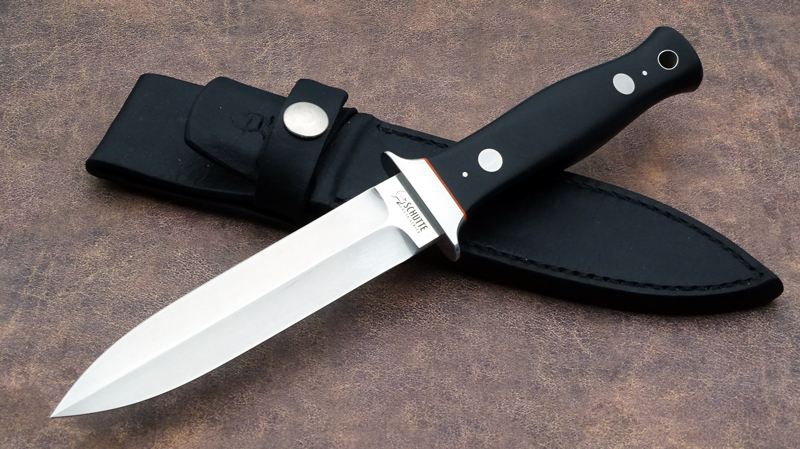Daggers: A Brief History



The dagger. Unlike the blade designs that carry the names; hunter, fighter, Bowie or even sword, daggers almost always conjure up a singular image in the mind. Primarily, a blade evenly ground on either side of a center line to a point and sharpened on both sides. Now the steel or the guard (or lack thereof) or handle may differ from knife to knife, but the blade remains the same.
My First Custom Tactical Dagger
My entry into the world of custom knives in 1984 saw the emergence of the golden age of art daggers. Buster Warenski left no doubt that he was the Master Craftsman of that era. Other makers doing exceptional work during that time included Willie Rigney, Fred Carter, and Billy Mace Imel. For those of you unfamiliar with any of the previous names I would encourage you to utilize your “Google-Fu” and search these makers and their work out. Having been a fan of the F-S Dagger, I was forced to stop at the table of Billy Imel at the Guild show in the early 1990’s. On his table was his version of the F-S dagger; beautiful, sleek and deadly. I’m sure other makers had done this before, but this is the first Fairbairn Sykes custom tactical dagger I remember seeing.
Dagger History

Daggers have been around as long as man. Early daggers were made of flint, ivory or bone either as a stand alone blade or attached to a piece of wood. As war and its weapons evolved, daggers were made from bronze and then later from iron ore. As armor, such as steel chain mail and plate armor were resistant to slashes and cuts, the need for a weapon to penetrate was created. The dagger was the ideal weapon for this using the reverse grip. The dagger was employed in a downward technique to increase the thrust and penetrative force. As armor fell out of favor the dagger became more of a weapon of choice. During the Renaissance era the dagger became popular as a secondary weapon to the sword; then to be used in concert with a sword. During this time the dagger became part of everyday dress and they were the only weapon the common man could carry without drawing attention to himself. During this time the dagger in the form of a bayonet attached to the end of the rifle was also implemented.
Perhaps the most familiar daggers to us were the ones that started to show up during WWI. Trench warfare demanded weapons for close-in work to be developed. Given the close quarters in the trenches, officers moved from carrying sabers/swords to wearing daggers. This trend for the officers continued after WW1 and into WW2. WW2 will be remembered for many thing; however, it may be the golden age of tactical dagger designs. Even though the Fairbairn-Sykes (F-S) and Case V-42 weren’t developed until seventy-five years later, they still captured the imagination of knife users, collectors and knife makers.
Fuller or Blood Groove
The fuller, or as some call it, the blood groove, is an additional step to this process. As it adds both time and an additional skill set to put this into the blade. A common misnomer is that the blood groove is added to allow blood to flow from a wound allowing the blade to be more easily removed. The other misnomer is that suction is created by the entry of the knife. The blood groove allows air to be introduced to the wound allowing for easier retrieval. The actual reason for the fuller is to remove weight from the blade while maintaining the strength. The act of twisting the knife would aid in retrieval much better than any groove in the blade.
Today’s Daggers
The custom fixed blade market is seeing a resurgence of tactical daggers. The tried and true variants of the F-S and Case V42 are making their appearance again.
A classic design will always find those who want to either own or make a knife based on a classic design. Other makers are providing their take on one of man’s oldest blade designs.
At first glance, the dagger blade seems to be a basic knife to grind. However, it is the symmetry of the blade that makes it very difficult to keep all four grinds symmetrical. It is the centerline from the front of the guard to the end of the tip that makes or breaks the symmetry. Failure to achieve that straight grind will eliminate the possibility of achieving that symmetry. Even for very well-known knife makers achieving the symmetry is not a given. While judging the custom knife competition at the Blade Show I have seen two knives; both with an asking price of at least $15,000.00 with a crooked centerline. Why the knife maker would knowingly let that knife out of his shop with that obvious mistake one can only guess.
As was shown by the soldiers of WWII the dagger can and will be used for a myriad of purposes. However, the blade did not always lend itself to the job at hand. Many FS daggers were ruined as their owners broke the tips trying to open ration cans. While today most will find their way into collections. The lethality of the dagger has not changed and most will be able to accomplish the chore they were designed for all those thousands of years ago.
Interested in purchasing your own Sykes Fairbairn or tactical dagger? Place an order for one by Walter Brend here.
